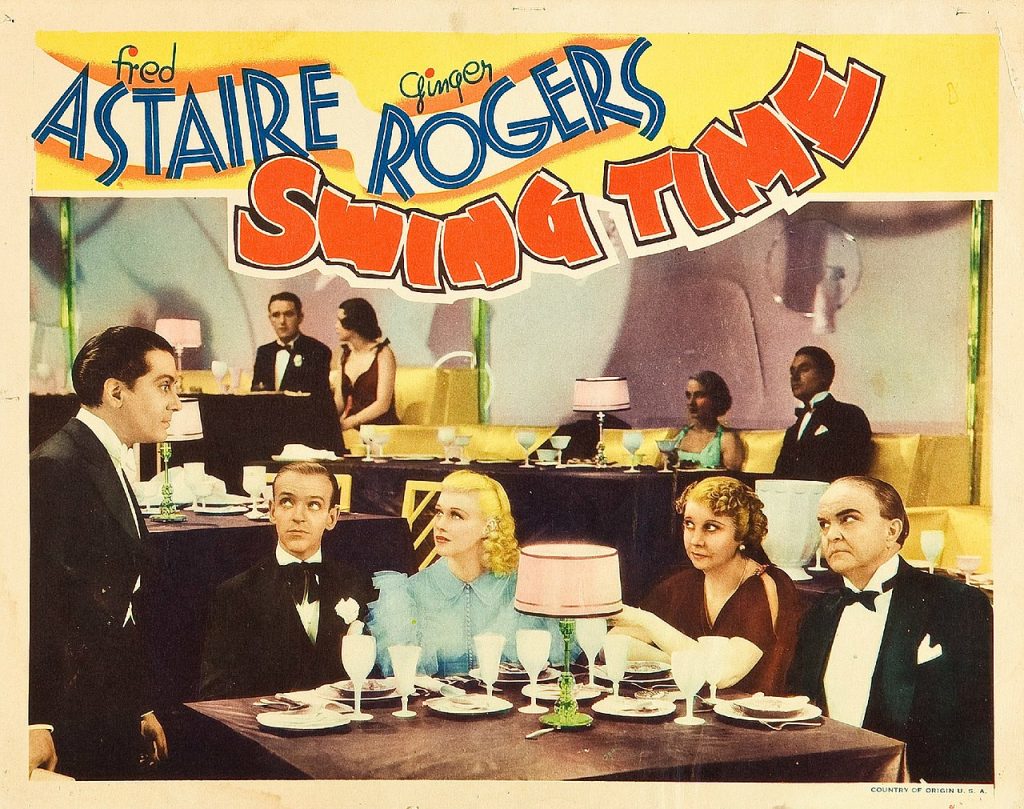The holidays have come and gone, and with them another opportunity to be upset by blackface. See, Turner Classic Movies runs films unedited, with what are now considered offensive scenes intact, so with every Christmas season comes the marring of otherwise great old films. One of the worst offenders is the 1942 Bing Crosby vehicle Holiday Inn. In addition to being the movie that brought us “White Christmas,” Holiday Inn features a truly offensive song about Abraham Lincoln sung by Bing Crosby and Marjorie Reynolds in blackface and wigs. (Reynolds’s outfit is…just…) The duo are backed by a band entirely in blackface, made worse by a cut to a black mother singing to her children in the kitchen while Bing and company frolic in the dining room. It is abysmal.
Then there’s the 1936 Fred Astaire–Ginger Rogers film Swing Time. Swing Time is a near-masterpiece, despite including a highly confusing blackface scene, the famous “Bojangles of Harlem” dance. On its face, the scene is a tribute to the great black tap dancer Bill “Bojangles” Robinson, but the blackface Astaire wears comes across jarring and unnecessarily racist. Yet the scene contains mesmerizingly beautiful dancing. Indeed, the New York Times’s Alastair Macauley called it “one of Astaire’s most rhythmically imaginative solos,” and described its opening thusly:
The opening image is a coarse Robinson caricature: gigantic shoe soles are upended to show a thick-lipped black face, topped by a derby and above a dotted bow tie. Then the women of a chorus tug the shoes apart to reveal giant trousered legs—at the end of which sits Astaire. The women bear those legs away. Astaire bursts forth, dancing.
See for yourself; skip to about 1:30 for Astaire, who does indeed burst.
It’s hard to know where to begin. The dancing and filmmaking (see the shadow film tricks toward the end) are great but the aesthetics are bad. Sure, Robinson was black and Astaire was white, but why did Astaire wear blackface? Is the dance a tribute, a parody, or something in between? And is Astaire’s loose-limbed style in “Bojangles of Harlem” a result of the blackface he’s wearing? By donning blackface (plus his clownish outfit) is Astaire allowing himself to dance more freely, even if that’s not how Robinson necessarily danced? (Astaire’s portrayal may not be of Robinson specifically, but that’s neither here nor there.) Compare Astaire’s Bojangles to the man himself in the below clip from the 1934 film King for A Day. Robinson’s style was more upright and delicate. His suit is also quite beautiful.
If 2017 taught us anything, it’s that we need to continually guard against rot. The mistakes of the past don’t necessarily stay there — especially as they concern race. Look for example at the reinvigoration of white supremacists (sorry: nationalists), at the angry young white men sieg heiling and carrying tiki torches. More recently, look at when a member of a Japanese comedy duo wore blackface for a New Year’s Eve special, or when Princess Michael of Kent wore a blackmoor brooch to lunch with Meghan Markle, or refer to the continued existence of the Netherlands’s Zwarte Piete tradition. Or consider, you know, uh, yesterday, when the President of the United States referred to El Salvador, Haiti, and the entirety of Africa as “shithole countries” during a discussion on immigration.”Why do we need more Haitians, take them out,” said our appalling, racist president.
One might argue that blackface performances of the thirties and forties (and earlier) are so far in the past and such a product of their time as to be beyond judgment, but I’d disagree. I’d rather assessments of artists be made with knowledge of their warts and all. For example, if and when I decide to watch a Woody Allen film, I know full well what I’m doing. As for Roman Polanski, I’m with Claire Dederer, per her November piece in The Paris Review, “What Do We Do With the Art of Difficult Men?” Chinatown is a masterpiece that was directed by a monster, and you should squirm when watching it.

The thing is, I love Fred Astaire. I was raised on a steady diet of Astaire films—particularly his films with Ginger Rogers, whom I also love. Top Hat is a perfect movie—his dancing is wonderful stuff, awe-inspiring and life-affirming. So I find “Bojangles of Harlem” both personally upsetting and intellectually perplexing, because the blackface Astaire wears is such an incredible disappointment, and because—like so much we learn about our heroes—it complicates the view of Astaire as a genial, widely beloved star of stage and film whose dancing gladdened millions. Astair certainly was these things, but he also participated in and perpetuated a harmful tradition of racist minstrelsy. The blackface Astaire wears in Swing Time, regardless of his intentions or the time in which he wore it, mars, and will continue to mar, his legacy.
But of course there is a silver lining to “Bojangles from Harlem”: it shines a spotlight on Robinson, who remains less well-known than Astaire. So without further ado, here’s another scene from King From a Day, of Robinson and chorus doing the Bill Robinson stomp. “Here we go / on your toes / holla hidey-ho / Bill Robinson stomp!” It is magical.
Swing Time lobby card header image via Wikimedia Commons
Robinson image via Wikimedia Commons / Library of Congress
“Bojangles of Harlem” scence via Dailymotion
King for a Day scenes #1 and #2 via Youtube




